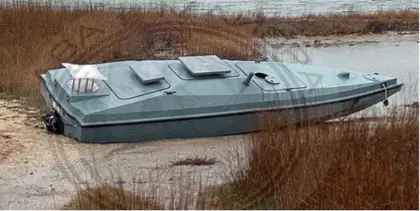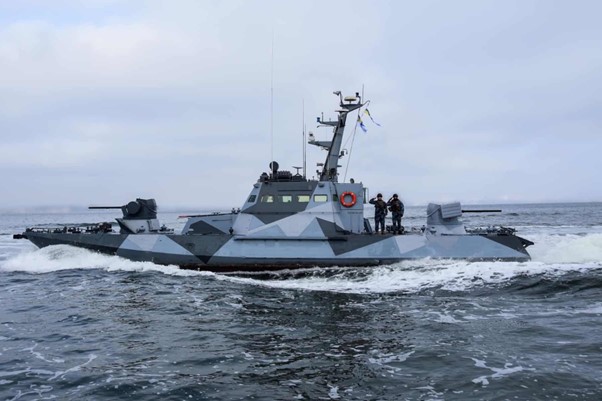In the early hours of March 5, yet another Black Sea Fleet (BSF) vessel was sunk as a result of an attack by Ukraine’s Magura-V5 unmanned surface vessels (USV), known more colloquially as sea drones.
The Russian patrol ship Serhiy Kotov became, according to the Oryx OSINT website, the 22nd naval vessel to be sunk by Ukrainian seaborn or airborne drones, or by ground or air-launched missiles, since the start of the full-scale invasion two years ago. Kyiv claims the figure to be even higher, at 26 vessels.
JOIN US ON TELEGRAM
Follow our coverage of the war on the @Kyivpost_official.
This latest attack came less than 10 days after the sinking of the BSF heavy landing ship Tsezar Kunikov which was struck by as many as three Magura-V5s off the southern coast of the occupied Crimean Peninsula.
In the wake of these successes, just what is it that makes the Magura such a formidable weapon?
History of the Magura
According to various sources, the name Magura is an acronym derived from: “Maritime Autonomous Guard Unmanned Robotic Apparatus V-type.”
Coincidentally, or not, Magura is also a figure from Slavic mythology. Daughter of the thunder God Perun, she was a cloud maiden considered to be beautiful, winged, and warlike – to many, the perfect personification of this USV.
The Magura-V5 was developed by a Ukrainian private company called SpecialTechnoExport (STE). Relatively little is known about the company, which keeps a low public profile for security reasons.

North Korean MLRS Disguised as Civilian Truck Spotted in Kursk
According to Ukrainska Pravda (UP), the original drone prototypes were offered to the Security Service of Ukraine (SBU). At that stage they had a simple design that bore little resemblance to the version in use today. It employed a single communication channel via Starlink and had a simple engine, navigation and control system.
Although the SBU recognized the value of USVs, it turned away from the Magura and decided to develop its own version – the Sea Baby.
At the same time, Ukraine’s directorate of military intelligence (HUR) had also been exploring the possible use of marine and airborne drones and created a separate department for the use of such unmanned systems, named “Group 13.” The head of the division, known by his call sign “Borets,” said the department had been working on seaborne drones since the summer of 2022.
Group 13’s initial approach was to modify existing water vehicles by installing remote control systems and explosive charges on items such as jet skis, scooters and motorboats. Borets said their first intention had been to use these amphibious drones for surveillance or “kamikaze” attacks on rivers and indeed had carried out such operations on the Dnipro River in the Zaporizhzhia region.
Borets said that he and his team began to look for more sophisticated “off the shelf” platforms and visited military exhibitions searching for products. Having failed to find anything that fitted the bill, they decided to look for a domestic manufacturer they could work with, finally settling on STE.
As Budanov told UP: “They were not the first to come to us, but we saw the potential in their developments. That's why we started to cooperate and are still cooperating quite successfully.”
Magura-V5 technical make-up
Both the HUR and STE are understandably tight-lipped about the technical and operational characteristics and capabilities of the USV. When it was publicly displayed at Turkey’s International Defense Industry Fair (IDEF) in July 2023, the following characteristics were declared.
- Length: 5.5 meters (18 feet);
- Width: 1.5 meters (5 feet);
- Height above the waterline: 500 mm (1.6 feet);
- Cruising speed: 22 knots (41 kph / 25.3 mph);
- Maximum speed: 42 knots (78 / 48.3 mph);
- Range: 450 nautical miles (833 kilometers / 518 miles);
- Payload: 320 kilograms (705.5 pounds);
- Communication: mesh radio with an aerial repeater or satellite communication.
Recently some of the veil of technical secrecy has been pulled back after a largely intact USV was recovered by Russian forces on the coast of Crimea in November.
Magura V5 USV recovered in Crimea, Nov. 22, 2023. Photo: Telegram
Open-source assessments of images taken from the recovered drone show the following:
Body construction: The Magura-V5 has a thin body made of carbon fabric and epoxy resin. This construction is considered similar to that used in the manufacture of unmanned aerial vehicles (UAVs).
Engine: The engine compartment is made from aluminum, incorporated into the hull using industrial standard polyurethane foam. It is fitted with a system between the engine and the outer top cover that cleans fuel vapor and helps reduce the thermal visibility of the vessel.
Communications: Communication is via two Starlink antennas and a US-made Kymeta satellite communications antenna. A separate communication channel uses an industrial dual-SIM cellular GPS capable router with a range of up to 40 kilometers allowing access to terrestrial mobile internet when close enough to shore.
Components of the Magura-V5 communication system
Computer control: The drone is fitted with a computer using Linux coding. According to comments on social media, Russians investigating the equipment considered it to have “messy electronics [that] make the drone unreliable.”
It is unclear if the recovered Magura is typical of the current versions being deployed but the successful use of it against Russia’s BSF, suggests comments about reliability should be taken with a pinch of salt.
Internal computer, wiring and other electronic linkages
Magura successes
The recent successes of the USV are a combination of technical improvements and development of the operational tactics employed by the HUR. They worked on this during the “off season” between November 2022 and March 2023, when conditions in the Black Sea were not conducive to deploying the drones. They realized that to better ensure success the USVs should “hunt in packs or swarms” of five or six to try to overwhelm the target ship’s weapons.
One of the drone developers said that each USV in a swarm has an individual task. In short, the lead drone tries to immobilize its target by hitting the engine area then the next in line attacks the vulnerable midships. If a breach is achieved, follow-up attacks are aimed at that spot.
By the beginning of April 2023, the USVs were considered ready to go. All that was needed was an appropriate target to present itself. At around the same time, the SBU began to use its sea drones the “Sea Baby” and the high speed Mamai USV. The various drones, being similar in appearance but having different roles, has caused some commentators to confuse the various types and their users when in use.
The Ivan Khurs: The first opportunity for the Magura appeared on May 24, 2023 when a Russian reconnaissance ship, the Ivan Khurs, was spotted operating about 120 kilometers (75 miles) northeast of the Bosphorus Strait.
Borets gave an account of how the mission very nearly didn’t take place because of bad weather. When the drones were finally dispatched, there were frequent breaks in communication. As the USVs approached the ship, they were engaged by the ship’s weapons and had to keep their distance, tracking the vessel for some six hours. Just as the USVs were running out of fuel, the attack took place.
Borets did not specify how many drones were involved but the Russians claime to have engaged and destroyed three and that the attack failed. A video published by Ukraine at the time confirmed that at least two drones were damaged by fire from the ship but one definitely struck the rear of the Ivan Khurs and probably caused severe damage.
Serhiy Kotov: The Magura encountered this patrol ship in July and again in September 2023 and claimed on both occasions to have caused damage to the vessel but failed to sink it. It was not until March 5, almost six months later, that they finally hit and sank the ship.
Serna and Akula: On the night of Nov.10 2023, the HUR drones identified two Russian high-speed landing craft, the Serna and Akula. The craft were positioned in a military harbor near the village of Chornomorske near the Crimean coast. At around 5 a.m., up to five of the Magura drones hit the two vessels causing them and their cargo of armored vehicles to sink.
Ivanovets: In the early hours of Feb. 1, several Magura USVs hit the guided-missile corvette Ivanovets at the entrance to the Lake Donuzlav inlet of the Black Sea on the coast of occupied Crimea. The ship sank, probably with the loss of most, if not all, of its 40-man crew. This was significant as it was one of only three of this type of vessel in service with the BSF. A video released by the HUR showed two direct hits, one causing a large hole in the side of the Ivanovets followed by another hit that caused a massive explosion.
Tsesar Kunikov: Early on Feb. 14, as many as six Magura-V5s attacked the heavy assault ship Tsesar Kunikov from both sides, close to the Crimean resort town of Alupka. Unlike with previous assaults, the vessel appeared to take no defensive action before being engulfed by an explosion, rolling on to its side and sinking.
The future of the Magura-V5
Unlike the SBU’s Sea Baby, which is a multi-purpose platform and can be considered a “jack of all trades,” the Magura was always intended to be solely a hunter/killer created specifically to seek out and destroy warships at sea. It is smaller, faster, and much more maneuverable than other, similar drones.
Even so, both the HUR and the manufacturer said they are investigating ways to develop the platform further, which could include the addition of air defense systems and other weapons systems on these drones. These would help to improve its protection but also allow it to seek out other targets: ground, surface, air. There are also plans to allow the USV to submerge slightly, making it even less visible during its final approach.
However, in contrast to that, Budanov said: “We are following the path of finding and destroying ships. This is our choice and we are developing these methods. Constant patrolling is not for us… We have decided that we work exclusively on ships.”
You can also highlight the text and press Ctrl + Enter













